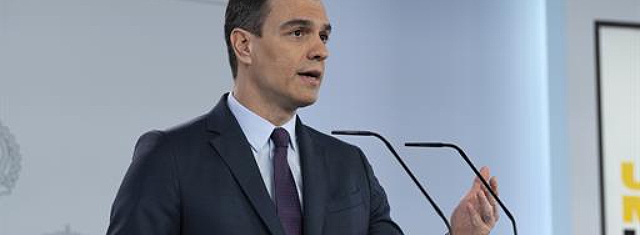Politics
Spain hopes to return to normal on June 30
Government approves a plan in 4 phases

Pedro Sánchez (Source: Moncloa Palace)
USPA NEWS -
The Spanish Government plans to regain normality throughout the territory on June 30. President Pedro Sánchez announced this Tuesday in a televised appearance, where he said that "the new normal" will arrive at the end of that month. To achieve this, the Government approved in the morning a plan for de-escalation - a term coined to refer to the process of returning to normality - "gradual, asymmetric and coordinated" among all regions. A plan that includes four phases and will start next Monday, May 11.
The Spanish Government allowed the children to go out on the street for one hour a day since last Sunday, April 26. From Saturday, May 2, those over 14 years old can also go for a walk and do sports. Nine days later, the de-escalation plan approved on Tuesday by the Council of Ministers will begin, a plan without dates but which aims to restore normality throughout the territory on June 30. "The sole purpose of this plan is to launch Spain protecting the health of citizens," said President Pedro Sánchez in his televised appearance. "At the end of June, if the disease allows it, we would be back to normal," he added.
The plan approved by the Government contemplates four phases from the current moment. It will be on Monday, May 4, when the Government decides which provinces can go to phase 1 and which should continue with the current restrictions. Moving to phase 1 will require that the regions are controlling the pandemic, that the hospitals are not collapsed and have the capacity to deal with new infections, and that health supplies are guaranteed in each territory.
In this phase 1, it will allow the opening of premises by appointment and individual attention, and of small shops - although with preventive measures such as limiting capacity or disinfecting their products when they can be tested; bars that have outdoor terraces; from churches, reducing their capacity, and from gyms with the same condition. Bars must establish a preferential schedule for their clients over 65 years of age. In public transport, occupancy restrictions will be maintained and the use of protective masks is recommended.
In phase 2, bars that do not have a terrace will be allowed to open, but they can only serve their clients if they have tables. Bar service is still prohibited. In this phase 2 sport hunting and fishing will also be allowed; they may open cinemas and theater with numbered seats, reducing their capacity by 30%; visits to monuments will be allowed and the cult centers may open, reducing their capacity by 50%. Meetings of less than 50 people in closed spaces and less than 400 people outdoors will be allowed.
The exception are colleges, institutes and universities. The school year will begin in September, said President Sánchez, and until then they will remain closed. Only its punctual opening is contemplated to reconcile work and family life, and to carry out the university entrance exams.
Each phase will last fifteen days. Except for the Balearic Islands and the Canary Islands, which will resume their activities on Monday, May 4, until May 11 all of Spain will be in phase zero. "All the provinces that meet the requirements will go directly to phase 1," announced President Sánchez. “At best, the transition to normal will take six weeks; in other cases, it will last eight weeks," he added. The de-escalation is asymmetric because "the pandemic has hit unevenly" in each territory. But it will be coordinated because it will be governed by the "same rules, although they are applied at different speeds in different spaces," said the President of the Spanish Government.
Sánchez appealed to patriotism to ask for patience and commitment from the Spanish. "The virus is not gone and will continue until we have an effective vaccine or therapy," he warned. The president will ask the Congress of Deputies as many extensions of the state of alarm as necessary until the end of the state of alarm.
Liability for this article lies with the author, who also holds the copyright. Editorial content from USPA may be quoted on other websites as long as the quote comprises no more than 5% of the entire text, is marked as such and the source is named (via hyperlink).





